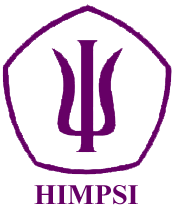Author Guidelines
Jurnal Sains Psikologi accepts research articles written in English. Author should make sure that maximum plagiarism checking on manuscript is 20% beforo submission. The contents and systematics of the written manuscripts are described narratively using the essay format in paragraph form, and do not use detailed grammatical systems such as thesis/dissertation (without subtitle numbering) and should contain the following components:
1. The title of the manuscript:
The title should be concise and straightforward to describe the content of the manuscript. It may use attractive and creative titles to attract readers (maximum 15 words).2. Author Name
Write the full name of the author without a title, the institution where the author work/study (affiliation) and the author's address of the correspondent (e-mail).
3. Abstract
The Abstract must be written in English and Bahasa Indonesia with 1.0 line spacing and a maximum of 250 words containing hypothesis, research subject, method, and result.4. Keywords
The main words in the study can be taken from the research variables, the characteristics of the research subject, and the referred theory ( Please provide five keywords, written in alphabetical order)5. Introduction
The title of introduction are not written and must contain preliminary, problems, and theoretical (shortly and consecutively) a general background and a literature review (state of the art) as the basis of the brand new research question, statements of the brand new scientific article, main research problems, and the hypothesis. In the final part of the introduction, the purpose of the article writing should be stated. In the scientific article format, it does not allow to write down the references as in the research report. They should be represented in the literature review to show the brand new of the scientific article.
6.Research Methods
The method is implemented to solve problems, including analytic methods. The methods used in the problem solving of the research are explained in this part.
7. Result
This part consists of the research results and how they are discussed. The results obtained from the research have to be supported by sufficient data. The research results and the discovery must be the answers or the research hypothesis stated previously in the introduction part.
8. Discussion
This part consists of the research results and how they are discussed. The results obtained from the research have to be supported by sufficient data. The research results and the discovery must be the answers or the research hypothesis stated previously in the introduction part.
9. Conclusion
This section is concise, clear and solid based on the results of the study (a maximum of 1 page), made in paragraph (not numerical) form, containing the findings as syntheses between the results of the analysis and the results of the study, and further highlighting the novelty contributing to the development of psychology10. References
Manuscripts should follow the latest edition of the American Psychological Association (APA) Style Manual. The References List is a Bibliography, it shall contain all sources referred to in the Manuscript, and shall not contain unused sources. The reference list contains all references in text originating from sources that are: (a) relevant, (b) at least 80% up to date (last 10 years), and (c) primary (at least 80%), mainly from the journal Manuscript. For the better format, we suggest to the author using citation app like Mendeley or Zotero.
Below are the examples of writing a reference from the following source:(a) Journal without Digital Object Identifier (DOI)
Light, M. A., & Light, I. H. (2008). The geographic expansion of Mexican immigration in the United States and its implications for local law enforcement. Law Enforcement Executive Forum Journal, 8(1), 73-82.
Arbiyah, N., Nurwianti, F., & Oriza, D. (2008). Hubungan bersyukur dengan subjective well-being pada penduduk miskin. Jurnal Psikologi Sosial, 14(1), 11-24.
(b) Journal with Digital Object Identifier (DOI)
Herbst-Damm, K. L., & Kulik, J. A. (2005). Volunteer support, marital status, and the survival times of terminally ill patients. Health Psychology, 24(1), 225-229. https://doi.org/10.1109/5.771073
(c) Magazine Manuscript
Chamberlin, J., Novotney, A., Packard, E., & Price, M. (2008, May). Enhancing worker well-being: Occupational health psychologists convene to share their research on work, stress, and health. Monitor on Psychology, 39(5). 26-29.
(d) Online Magazine Manuscript
Clay, R. (2008, June). Science vs. ideology: Psychologists fight back about the misuse of research. Monitor on Psychology, 39(6). Diunduh dari: http://www.apa.org/monitor/ tanggal 10 Agustus 2012.
(e) Newspaper Manuscript (No Author)
Six sites meet for comprehensive anti-gang initiative conference. (2006, November/December). OJJDP News @ a Glance. Diunduh dari: http://www.ncjrs.gov/htmllojjdp/news_acglance/216684/topstory.htmI tanggal 10 Agustus 2012
(f) Unpublished Thesis/Disertation
Rimawati, A. B. (2010). Model teoretik prasangka sosial. (Disertasi tidak dipublikasikan). Fakultas Psikologi Universitas Gadjah Mada, Yogyakarta.
(g) Book
Azwar, S. (2012). Penyusunan skala psikologi (ed.2). Yogyakarta: Pustaka Pelajar.
(h) Book (with Editor)
Cone, J. D. (1999). Observational assessment: Measure development and research issues. Dalam P. C. Kendall, J. N. Butcher, & G. N. Holmbeck (Eds.), Handbook of research methods in clinical psychology (hlm. 183-223). New York: Wiley.
(i) Unpublished Manuscript
Nuryati, A., & Indati, A. (1993). Faktor-faktor yang memengaruhi prestasi belajar. Manuskrip tidak dipublikasikan, Fakultas Psikologi, Universitas Gadjah Mada, Yogyakarta.




1.png)







